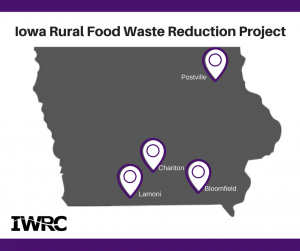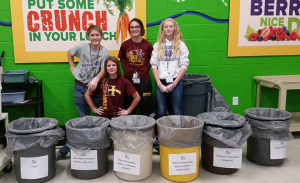Many of IWRC’s food waste reduction projects focus on helping certain industries reduce their food waste but from September 2016-October 2017, efforts had a larger frame in mind - Iowa communities. Through the Iowa Rural Communities Food Waste Reduction Project, funded by the United States Department of Agriculture Rural Utilities Service, the IWRC worked with four communities throughout Iowa: Postville, Chariton, Lamoni, and Bloomfield.
 The project had two components - working with industrial, commercial, and institutional (ICI) entities and working with residents. Efforts in each city were different based on the needs of the community.
The project had two components - working with industrial, commercial, and institutional (ICI) entities and working with residents. Efforts in each city were different based on the needs of the community.
Lamoni, IA
The IWRC was able to work with the community of Lamoni through multiple facets. While attending the Food Citizen Symposium in April 2017, 20 Lamoni residents were provided with the necessary tools to track food waste at home including a digital kitchen scale, tracking sheets, home composting guides, and strategies to prevent and reduce food waste utilizing the U.S. Environmental Protection Agency’s Food: Too Good to Waste Program.
Additionally, the IWRC worked with Graceland University and Lamoni Community Schools to conduct waste audits. The schools were already doing a lot to prevent and reduce food waste such as having students sort their trays after meals, having a share table for leftover edible food and beverages, and dumping leftover milk and juice down the drain rather than throwing it in the garbage. All very simple but effective techniques.
Through the waste audit at the schools, the results showed that each student throws away an average of 0.15 pounds of food daily. With four years of waste audits at K-12 schools under its belt, the IWRC has established an average of 0.4 pounds of food during lunch per student. Lamoni’s 0.15 shows how much their techniques are reducing food waste already.
 On a much larger scale, Graceland University’s audits show that students tossed an average of 0.17 pounds of food waste daily even though much of the food waste generated is thrown in the garbage. Working with the university’s Sustainability Coordinator, the IWRC was able to share many strategies that could be implemented, one centered on getting food to those that are food insecure.
On a much larger scale, Graceland University’s audits show that students tossed an average of 0.17 pounds of food waste daily even though much of the food waste generated is thrown in the garbage. Working with the university’s Sustainability Coordinator, the IWRC was able to share many strategies that could be implemented, one centered on getting food to those that are food insecure.
The university throws away a good amount of food that is still edible and can be donated throughout the community. The university has interest in donating this food and possibly even providing meals for the community on a weekly basis. Funding is needed for this venture though so they are on the lookout for grants to help fund the project.
You can check out the full Lamoni Case Study here.
Bloomfield, IA
Working with Bloomfield came through two different focuses - the Bloomfield Farmers Market and the Davis County Community School District.
The IWRC was fortunate to be approved to be at the local farmers market to distribute free toolkits to residents. In total, 20 residents went home that day with the kit and were able to start reducing food waste right away. The kit included a digital kitchen scale to measure food waste, a reusable lidded soup mug to weigh food waste in, as well as information about tracking food waste and strategies to implement in their kitchens.
When it came to the schools, the IWRC was on hand, along with a representative from the Iowa Waste Exchange, to conduct a waste audit. The district has three schools; an elementary, middle, and high school. Both the elementary and middle schools share one kitchen but have two separate cafeterias while the high school is situated close by and has a separate kitchen and cafeteria. Waste sorts were conducted at all three cafeterias and included kitchen waste from both kitchens.
 One of the best things about working with the middle school was the student involvement!
One of the best things about working with the middle school was the student involvement!
Kitchen and post-consumer food waste was measured and calculated into the IWRC’s final report. In total, Davis County CSD generates a daily average of 239 pounds of food waste from 846 students during lunch while the kitchens throw away a daily average of 30 pounds. Combined, that average jumps to 48,420 pounds (24 tons) of food waste each year that is sent to the landfill.
But luckily, coincidently timing was in the district’s favor with their interest in food waste reduction. The IWRC was working with the City of Bloomfield providing guidance on incorporating food waste into their yard waste area at the local landfill. The school district is planning on hauling the school’s food waste a short distance to the city’s yard waste composting site which already has a reliable source of carbon to mix with the food waste. This partnership between the City of Bloomfield and Davis County CSD promulgates a successful situation where food waste is diverted and residents of the community are provided with free compost. You can check out the full Bloomfield Case Study here.
To learn about the other two communities involved in this project, take a look at Iowa Rural Communities Food Waste Reduction Project: Postville and Chariton. You can also check out other food waste reduction resources from the project at the Iowa Rural Communities Food Waste Reduction Project page.
The Iowa Waste Reduction Center and the University of Northern Iowa are equal opportunity providers and employers.
This material is based upon work supported under a grant by the Rural Utilities Service United States Department of Agriculture. Any opinions, findings, and conclusions or recommendations expressed in the material are solely the responsibility of the authors and do not necessarily represent the official views of the Rural Utilities Service.

